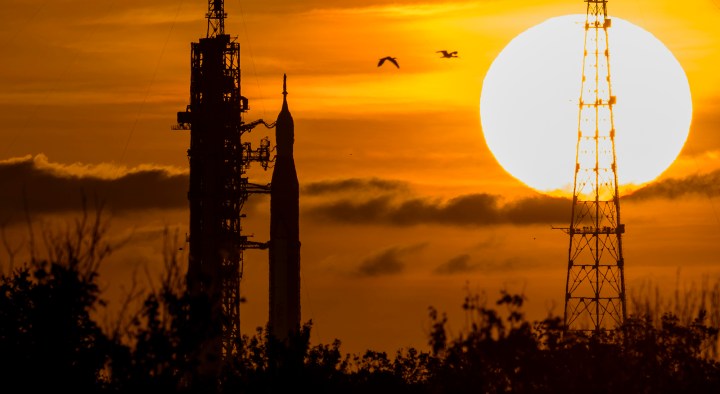BUSINESS REFLECTION
After the Bell: Watch this space (race)

The pace of rocket launches worldwide is absolutely (honestly, you just can’t help yourself) exploding, and the simple reason is that the cost of getting into space is plummeting and the expertise required is broadening.
When a rocket explodes, the technical term in the industry is that it experienced a “rapid unscheduled disassembly”. The term has all of the hallmarks of what might be called euphemism by technical overstatement. It’s in the same category as a used car being called a “certified previously loved vehicle”, but with a much, much less impressive explosion.
Well, according to a new report by the World Economic Forum (WEF) released on Monday, the space industry is in for the opposite: a rapid, scheduled assembly. The report finds that the space industry is about to — sorry, irresistible — take off. Currently, the industry is worth about $630-billion and that will increase to $1.8-trillion by 2035, serving an increasingly connected and mobile world, the report says.
Often these reports are slightly rooted in boosterism and massively overstate the longer-term outcome to impress and capture the news cycle. But weirdly, I think this estimate might be an understatement. I’ll come back to that, but first, it’s worth recapping some of what has been happening in the industry in the recent past.
The first thing to notice is that the pace of rocket launches worldwide is absolutely (honestly, you just can’t help yourself) exploding, and the simple reason is that the cost of getting into space is plummeting and the expertise required is broadening. Econ 101. In 2014, there were three orbital launches during the year. Last year there were 211 successful launches. So far this year, there have been 65, roughly 20 a month, so another record seems likely to be broken this year.
On one day during this past week, three SpaceX launches were due to happen — however, one was postponed because of the weather and took off the next day. The point is that the SpaceX launch schedule is now being held up not by the lack of rockets but by the lack of seaborne landing platforms, which is technically not a huge problem to fix.
Although SpaceX is the clear international leader, others are not insignificant. China has launched 15 rockets this year, Russia five, Japan three, India and Iran two. The countries to watch, I suspect, are not the regulars, the US, Russia and China, but the newcomers, especially Japan and India, for the simple reason that success breeds success in this industry.
What is driving this increase? This is where I find the WEF report so interesting. The first is the decrease in launch costs. It’s now about 10 times less expensive to launch a satellite into space than it was 20 years ago.
Second is commercial innovation, and this is not just in building rockets, but on the ground too, with the construction of smaller, more powerful satellites, better software and more applications. There has been a very rapid increase in private sector investment, which the report estimates was about $70-billion in 2021 and 2022.
Third, with the increase in commercial innovation, there has been a concomitant increase in potential investment applications, and by far the most important of these is communication. Up till now, satellites were all about spying, because they are a more efficient way of observing the Earth than flying supersonic planes all over the globe. That will continue of course.
But now, possibilities are (sorry!) dropping out of the sky; space tourism is the most obvious, but the one that I think could be very interesting is space-based Earth observation (EO). The applications here in agriculture, disaster management, traffic management, crime prevention and weather observation are just kinda endless. The report says the cost of real-time space-based EO is dropping fast and the quality is incredible. I’m not sure what this means, but a resolution of 15cm is now available, and images are now much more affordable because the per-pixel cost has continued to drop.
Fourth, the report says, the industry is being propelled by excitement. A host of the launches are about returning a human presence to the Moon after a 50-year gap. There is now a new race to land probes on the Moon, but the idea is really to build a permanent Moon base, and you can easily see that becoming a major “soft-power” geopolitical propellant. The state sector is still crucial here and there are plenty of Earthbound opportunities.
For example, Thailand, the report records, launched a five-year plan in 2022 to conduct Thai-based satellite design and development research, starting with its TSC-Pathfinder satellite for Earth observation. It’s also developing a domestic launch site to support launch demand in Asia.
To this list, I would add a fifth aspect: competition. One thing we have not seen much of yet is Amazon’s Project Kuiper, but you should never underestimate billionaire competition. The project is backed by Amazon and will focus on the PNT (positioning, navigation and timing) industry, EO and, crucially, communication. At the moment, Elon Musk is winning this battle hands down, but if there is one thing we know about Amazon’s founder, Jeff Bezos, it’s that he is persistent.
So, why do I think the august writers of the WEF report, in this case, WEF MD Jeremy Jurgens and McKinsey senior partner Ryan Brukardt, might be underestimating the potential? I suspect it has to do with the astounding success of SpaceX’s Starlink project, which provides internet access to remote areas. It’s technically aimed at areas where ground-based internet connection is not possible because it’s just too expensive to compete with fibre. You can tell by the urgency that SpaceX is applying to its larger rockets, which will launch larger satellites in larger numbers, that the cost/income equation might be on the verge of changing.
And then there is the possibility of direct-to-cellphone satellite connections. If and when that happens, well then we have a totally new game, because at that point the $1-trillion annual income of the global mobile phone operators becomes a target — or perhaps they become partners. Satellite comms may become the wholesale provider to the mobile phone industry.
How this plays out is still to become clear, but what we know is that Starlink’s planned second-generation satellites will be able to provide mobile provider T-Mobile in the US with 2-4 Mbit/s capacity per sector (a sector is about 15 square kilometres). So, the initial plan is that T-Mobile will support text messaging, but not high-bandwidth applications like voice calls and streaming video.
But trust me, this is just the beginning. Watch this space. DM



















As long as we can launch a good number and variety of space telescopes quickly enough to make up for the loss of “dark night” observations caused by the growing number glowing satellite streaks.
And there’s Kessler Syndrome to worry about if the satellites’ positions can’t be kept stable. Oh, and just how easy it becomes to stymie global Comms from satellite kill vessels (already causing problems from Russia and China’s successful tests).
As with anything, if the risks are well managed this should be a boon to our civilization.